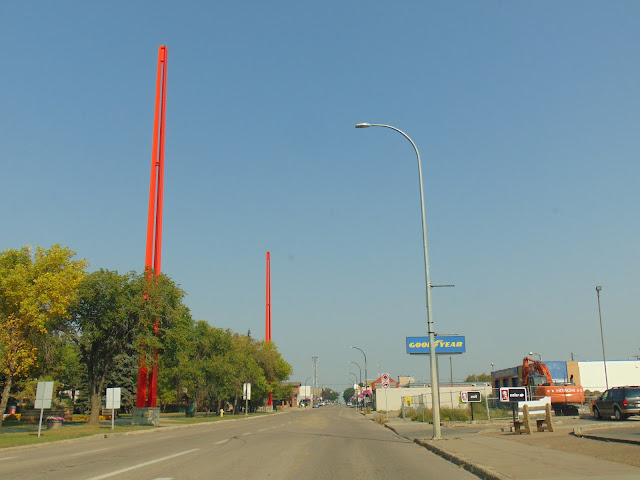The border markers that stand tall accentuate the story of Canada's border city. It's a story of a town, but two provinces. Lloydminster straddles the border between Alberta and Saskatchewan, and there are four giant red border markers at about 100 feet tall each in the center of town around the vicinity of City Hall and the Yellowhead Highway (Highway 16 in both provinces). Near the crossing of Highway 16 and Highway 17 (which follows the border between the two provinces) next to Lloydminster City Hall, the four markers stand on the boundary, representing the four themes of the story of Lloydminster, which includes the oil and gas industry, the Barr Colonists that founded Lloydminster, agriculture, and First Nations and Métis peoples. The gap between the steel pillars of each monument represents the actual border, and the border markers were erected in 1994.
Lloydminster was first settled by the Barr Colonists in 1903, which predated the creation of the border between Alberta and Saskatchewan, which became a province in 1905. The provincial border runs through the middle of the city through the Dominion Land Survey's Fourth Meridian, also known as the 110th meridian west. In 1930, Lloydminster was chartered in both provinces, thus making it the only municipality in North America to be chartered in two jurisdictions. However, modern GPS has shown that the border and meridian are slightly off. In 2005, it was discovered that the Fourth Meridian, which was surveyed during the 1870s, had turned out to be inaccurate. As a result, the true meridian doesn't run north-south along Lloydminster's 50th Avenue, but rather a few blocks to the east. However, the border markers are not going anywhere, standing as a testament to Lloydminster's unique status in the world.
 |
| Traveling east on the Yellowhead Highway (AB 16/SK 16), where a sign marking the border has been placed near one of the tall border markers. |
 |
| Traveling west on the Yellowhead Highway, you can see two of the border markers (one is obscured by the trees). AB/SK 17 follows the provincial border as well. |
How to Get There:
Sources and Links:
Tourisme Alberta - Border Markers
Tony Bloom Studios - Border Markers
City of Lloydminster - Border Markers
Behind the Hedge - North Along the Fourth Meridian
Conde Nast Traveler - The Strange Story Behind One Canadian City's Border Confusion (Ken Jennings - February 23, 2015)


Comments